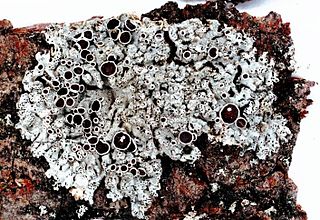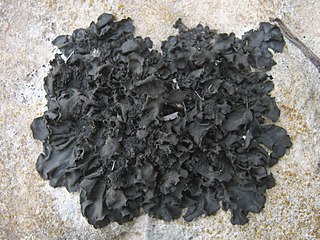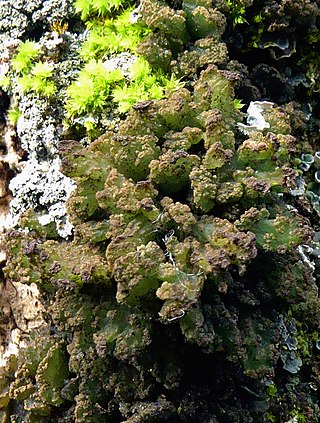
Physcia stellaris is a species of lichen. It is pale grey, but darker in the centre, and lacks isidia, lobules, soredia and pruina.It tests positive K+ yellow upper cortex with a 10% potassium hydroxide solution. In North America, it is known colloquially as the fringed rosette lichen.

Collema is a genus of lichens in the family Collemataceae. The photobiont is the cyanobacterium genus Nostoc. Species in this genus typically grow on nutrient-rich bark or somewhat siliceous or calcareous rocks in humid environments.

The Collemataceae are a lichenized family of fungi in the order Peltigerales. The family contains ten genera and about 325 species. The family has a widespread distribution.

Pseudephebe is a genus of fruticose lichens in the family Parmeliaceae. It contains three species that grow on rocks.

Leptogium is a genus of lichen-forming fungi in the family Collemataceae. It has about 110 species. Species formerly classified under Leptogium have since been divided among the genera Leptogium, Pseudoleptogium, and Scytinium. Leptogium lichens are predominantly found on tree bark or soil, often among mosses, and sometimes on rocks in moist environments.
Arctomia is a genus of lichen-forming fungi in the family Arctomiaceae. The genus was originally circumscribed by Theodor Magnus Fries in 1861. Arctomia has a circumpolar distribution.
Punctelia riograndensis is a species of foliose lichen in the family Parmeliaceae. Found in Africa and South America, it was formally described as a new species by Norwegian lichenologist Bernt Lynge in 1914, as Parmelia riograndensis. The type specimen was collected in 1892 from Porto Alegre Municipality in Rio Grande do Sul State (Brazil) by Swedish lichenologist Gustav Malme. In 1982, Hildur Krog circumscribed the genus Punctelia to contain Parmelia species with rounded pseudocyphellae, and P. riograndensis was one of the 22 species that she transferred to the new genus.

Blennothallia is a genus of jelly lichens in the family Collemataceae. It has four species, which collectively have a cosmopolitan distribution.

Scytinium is a genus of lichen-forming fungi in the family Collemataceae. It has 49 species. These lichens are typically found on basic rocks, soil, and trees, occasionally in association with mosses. Despite the morphological and ecological diversity within Scytinium, its species share similar ascospore features, such as shape and septation, as well as a small to medium-sized thallus with at least a partial cortex.

Lathagrium is a genus of lichen-forming fungi in the family Collemataceae. It has 10 species of gelatinous lichens. Species in this genus typically grow on calcareous rocks, often amidst mosses, but can also be found on siliceous or serpentine rocks, mortar, or soil.
Punctelia diffractaica is a species of foliose lichen in the family Parmeliaceae. It is found in Peru.
Leptogium patwardhanii is a species of corticolous (bark-dwelling) and foliose lichen in the family Collemataceae. Found in India, it was formally described as a new species in 2010 by Archana Dube and Urmila Vasudev Makhija. The type specimen was collected in an evergreen forest in Amboli (Maharashtra) at an elevation of 690 m (2,260 ft). It is only known to occur at the type locality.

Gabura is a genus of lichen-forming fungi in the family Arctomiaceae. Although it was originally circumscribed in 1763 by French botanist Michel Adanson, the name was nomen rejiciendum–it was "suppressed" against the conserved name Collema, and for a long time considered a synonym of Arctomia. In 2014, Per Magnus Jørgensen proposed to use the name Gabura for what was then known as Collema fasciculare. The name was formally resurrected for use in 2020. Gabura has three species transferred from the genus Arctomia following molecular phylogenetic analysis.
Sagiolechiaceae is a small family of lichen-forming fungi in the order Ostropales. It contains two genera, Rhexophiale, and Sagiolechia, the type genus. The family was circumscribed in 2010 by lichenologists Elisabeth Baloch, Robert Lücking, H. Thorsten Lumbsch, and Mats Wedin. Molecular phylogenetic analysis showed that the two genera formed a distinct clade in Ostropales. Four species were included in the original circumscription of the family.

Rostania is a genus of lichen-forming fungi in the family Collemataceae. These lichens are primarily found on tree bark, occasionally on wood, with one species known to inhabit soil. The genus is characterized morphologically by having minute thalli made of hyphal tissue without a separate cortex, and the more or less cuboid-shaped ascospores.
Abrothallus granulatae is a species of lichenicolous fungus in the family Abrothallaceae. Found in South America, it was formally described as a new species in 1994 by Swedish lichenologist Mats Wedin. The type specimen was collected by the author on the eastern shore of Lago Roca in Tierra del Fuego National Park, where it was found on the thallus of the foliose lichen Pseudocyphellaria granulata, which itself was growing on the base of a dead Nothofagus tree. The species epithet of the fungus refers to the epithet of its host lichen. The anamorph form of the fungus was concurrently named Vouauxiomyces granulatae. Characteristics of the fungus include the dense clusters formed by its apothecia, and its 2-septate ascospores. Abrothallus granulatae has also been collected in Chile.

The Collematineae are an suborder of rust fungi in the order of Peltigerales in the class Lecanoromycetes.

Gabura borbonica, previously known as Arctomia borbonica, is a species of foliose lichen found on Réunion, an island in the Mascarene archipelago. This species is unique due to its distinct features such as a crumpled, blue-grey to brown thallus and the production of structures called goniocysts at its margins. G. borbonica was transferred to the genus Gabura in 2020, and is distinguished from its sister species, Gabura insignis, both genetically and morphologically.
Opeltiella is a genus of lichen-forming fungi in the family Candelariaceae. The genus, established by Sergey Kondratyuk in 2020, has four species. It is differentiated from the similar genus Candelaria by its unique features such as eight-spored asci and absence of a lower cortical layer and true rhizines. The genus is characterised by its areolate to more or less squamulose or foliose thallus and the unique chemical substances it contains, such as calycin, pulvinic and vulpinic acids, and pulvinic acid lactone.












